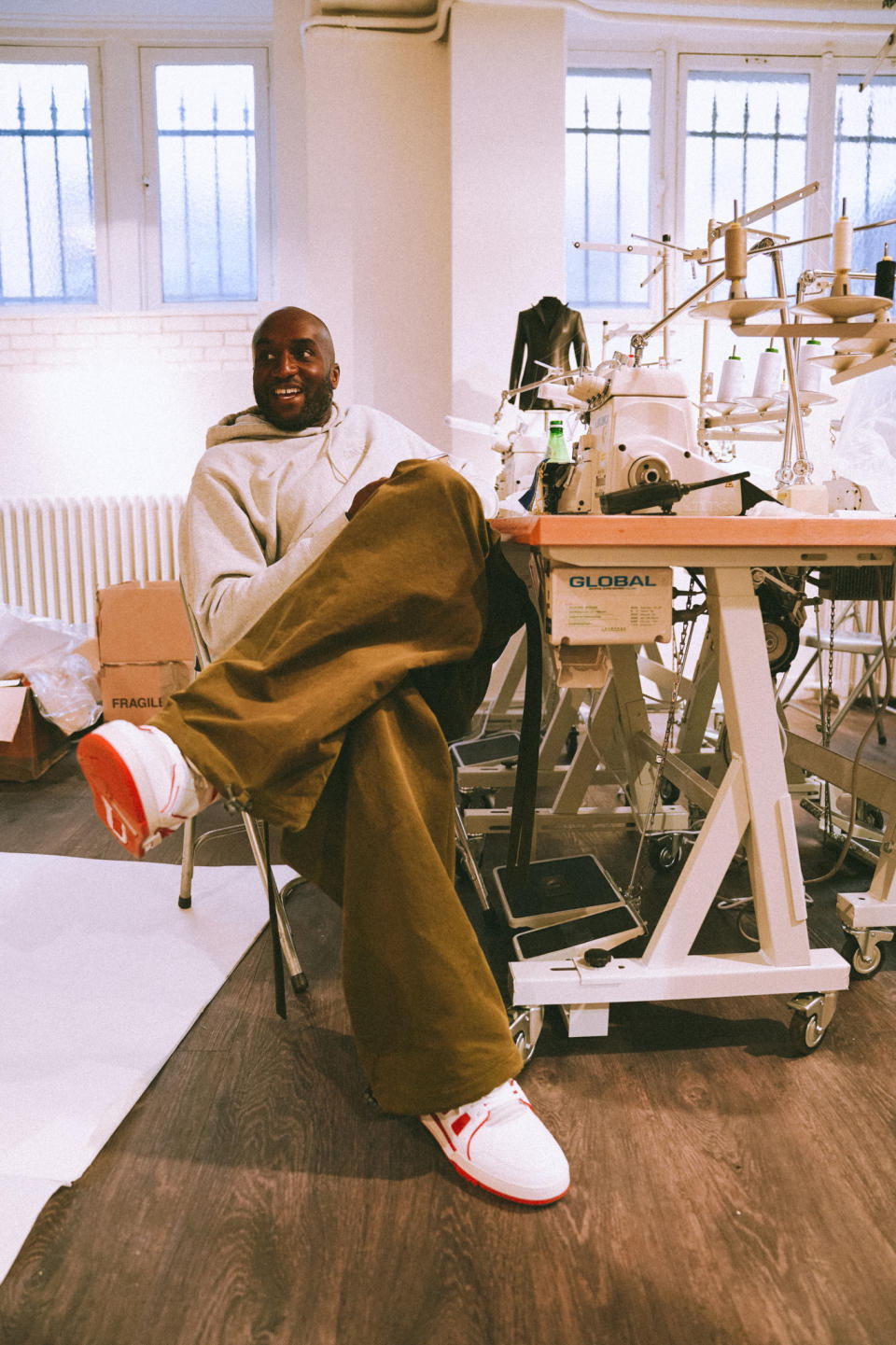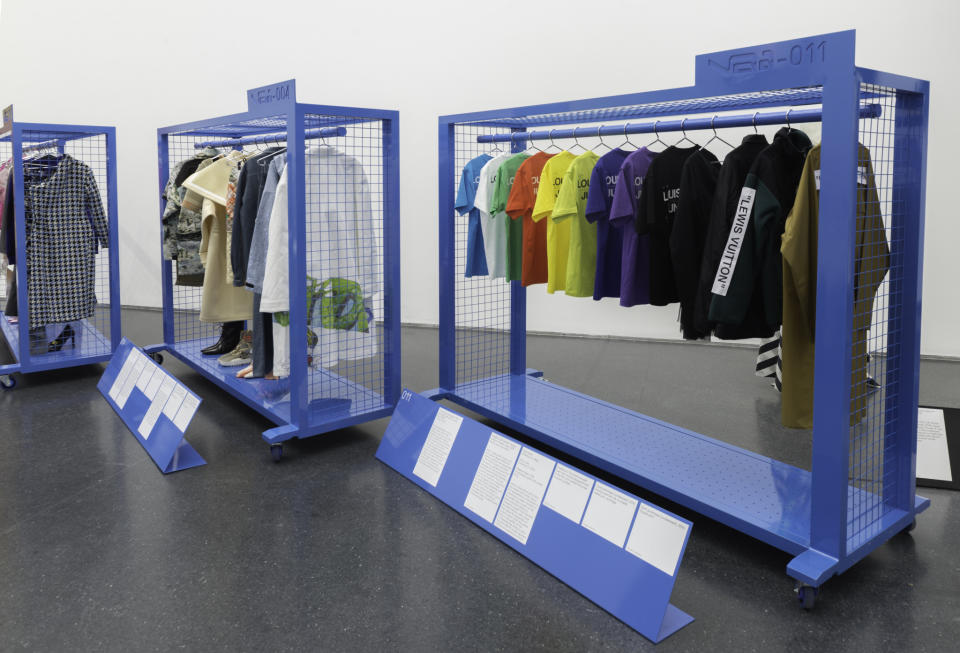Virgil Abloh’s Legacy Will Be Seen in Future Generations, According to Museum Curators

While many designers see themselves as a multihyphenated talent, Virgil Abloh lived up to that mantle through his ambidextrous creativity and boundary-breaking pursuits.
The Off-White founder and Louis Vuitton’s artistic director for men’s wear, who died earlier this week at the age of 41, was a multidisciplinarian through and through. Art, architecture, music, industrial and automotive design, street life and other elements were infused in his seemingly nonstop pursuits, which extended beyond the realm of fashion. However straightforward some of his designs might have appeared to be, Abloh often delivered the subversive and, in doing so, upended an hierarchy that had been decades in the making. Along with Nike, Levi’s and Moncler, other powerhouse brands like Ikea and Mercedes-Benz enlisted Abloh to help envision a smattering of their next-level designs.
More from WWD
The rise of a Rockford, Ill.-born artist, architect and fashion designer inspired legions of other creatives and consumers to carve new roads to their definitions of success. By his own account, he first learned to fuse the fields of art, craft and design as a postgraduate student at the Illinois Institute of Technology, where he was introduced to a curriculum established by Mies van der Rohe that had sprung from the Bauhaus movement.
High-minded, but ironic and seemingly always in-on-the-joke, Abloh stoked the dualism of his work on his personal site. Visitors will find a breakout for “The Struggle of Polar Opposites,” including such pairings as “Suit vs. Tracksuit,” “Day Job vs. Night Job” and “Sport vs. Spectator.” Skilled at reiterating different designs and themes for new meanings, Abloh first broached the “Polar Opposites” concert through an Off-White x Nike Air Presto drop in 2019. More recently, he had taken a group of architectural and design students under his wing through a London-based studio that he set up.
Michael Darling, a former curator at the Museum of Contemporary Art in Chicago, first reached out to Abloh in 2016 about the prospect of working together. Intrigued by Off-White, his furniture design, Chicago upbringing and engineering and architectural background, Darling decided upon meeting him that they should do something significant. After debuting at MCA Chicago in 2019, “Virgil Abloh: Figures of Speech” has been shown at Atlanta’s High Museum of Art and the ICA Boston, and is now on view at The Firehouse in Qatar until April. Next summer, it will bow at the Brooklyn Museum.
By the time that the show opened in Chicago in 2019, Abloh had morphed into a household name and the turnout reflected that. Following Abloh’s death, Darling said he has been thinking a lot about the designer’s legacy. “So much of what he’s done has happened quite quickly and before our eyes. The impact of it is still unknown. So many young people who he has impacted are just getting started; we haven’t seen the full impact of his influence yet.”
In addition to encouraging the younger generations to not feel bound by genres or certain ways of doing things, Abloh has also encouraged young designers of color to go out and chase their dreams, Darling said. Whether lending a hand or offering contacts, the designer helped them. Recognizing the influence of Abloh’s work with Kanye West’s Donda group, as well as Matthew Williams (now at Givenchy), Heron Preston and Samuel Ross (now of A-Cold-Wall), Darling said, “there was the incredible group of people, who were all working together and tormenting this new wave of creativity in the early 2010s that is still totally under recognized.”
Too young and too generous to be thinking about his legacy, Abloh wasn’t an egomaniac but was someone “who was always thinking about the broader culture and his generation of creatives, and wanting that whole group to succeed and leave their mark,” he added. Although he always made time for his family and a bevy of projects, Abloh was always all-in, when’re he was working. “He always questioned any path forward to make sure it was the best or most interesting or exciting one. He usually had multiple projects in his head at one time. As you were walking down regarding street with him, he would be texting, Instagramming and seeing things that he was making notes of. He was just constantlyprocessing that way, which was pretty amazing to witness,” Darling said, who is now Museum Exchange’s chief growth officer.
Andrew Bolton, the Wendy Yu curator in charge at the Metropolitan Museum of Art’s Costume Institute, said Monday, “Virgil both appreciated and explored the power of fashion as language, employing linguistic tropes such as irony and metaphor as cultural commentary. Placing fashion at the very center of contemporaneity, he was a semiotician of our times, encoding clothes with meaning and purpose. His singularity and magnanimity will be greatly missed.”

Bogdan Plakov/Courtesy of Museum of Contempary Art Chicago
The Brooklyn Museum’s senior curator of fashion and material culture Matthew Yokobosky said news of Abloh’s passing prompted such images as “the prismatic carpet that he created for his first Louis Vuitton men’s wear collection that was walked by an international cast of models, thereby staging the vocabulary of gay pride and inclusivity into one of the most anticipated, photographic events of recent years, and transmitting a seriously new perspective at the house.”
He was also reminded of an Off-White leather bag emblazoned with the word “sculpture,” which prompted viewers to consider what is art, what is fashion and is a handbag sculpture. Yokobosky also recalled the industrial hazard striping used as a brand/collection signifier for Off-White that Abloh chose to blur and explore the black-and-white lines that society has created through fashion — a challenge to the status quo. Also fond of Off-White’s precursor brand name Pyrex Vision, the curator asked, “Can anything be more clear and precise? While Virgil was asking us to question and reason through his designs or ‘makes,’ he was being very clear and purpose-driven about the visual ‘awareness’ journey that he wanted to take us on.”
Another admirer of Pyrex Vision was the Museum of Modern Art’s senior curator of architecture and design and director of research and development, Paola Antonelli. Instead of tagging items like a graffiti artist as he had in the past, Abloh “blossomed” at Louis Vuitton, where he was “innovating the essence of the objects and using different typologies for the garments and rethinking them from scratch with new forms and configurations,” she said. Using a leather harness or belt across the chest or shoulder that was reminiscent of Geoffrey Beene, for example, was a very elegant way to give a completely new turn to a suit without losing its essence, she said. “It’s a moment, where fashion is experimenting so much, especially men’s fashion, which is not even gendered any more. He really gave it a push in that direction.”
Abloh’s long-range legacy “will be the abundance of young people, who have been introduced to a world that they didn’t think was theirs, and they will just feel comfortable in it,” Antonelli said. “We will remember the objects, the branding and the logos. But he always opened my heart, because he was always like the Pied Piper with all these kids following him all the time…his most important legacy will be the inspiration that he has given so many kids all over the world and of all different backgrounds and especially kids of color.”
His ability to always design for his 17-year-old self was a point of distinction and a gift that gave him “a different way to be attuned to reality,” she said.
Valerie Steele, director of the Museum at the Fashion Institute of Technology, recalled Monday visiting the exhibition in 2019 with a group of other museum directors. Seeing clothes included in the show “just on a rack” rather than on a mannequin or on a pedestal with a light shining on it, raised the question of “‘This is how you’re showing them in an art gallery?’ But he was showing them in conjunction with other kinds of art projects. He was looking at it all like an art project,” Steele said. “In that way, he was very much like Andy Warhol or Jeff Koons — someone who is doing things that [make] some people go, ‘That’s not art’ or, ‘Oh well, it seems like it’s art.’ I’m an artist. I’m doing it. In that way, it’s very interesting conceptually.”

Courtesy of Museum of Contempary Art Chicago
As was the case with a Haruki Murakami exhibition, the exhibition had a shocking element — the show had racks of clothes, and the gift shop did too for purchase, Steele said.
She expects his lasting impact to be twofold: “One, as a Black person who became super important in the international luxury fashion industry at a very high level as influential and given quite a free range to go across different parts of the LVMH empire. That fits into the second aspect of why I think he is important — his disruptive ability to break down what seemed like barriers between different areas of culture and visual culture.”
As someone, who was interested in fashion from a young age, Abloh wasn’t interested in just fashion, but also art, music, skateboarding, luxury and streetwear, said Steele, noting that he was breaking down the distinctions between some of these things. “I’ve spent years thinking about, ‘How can you look at fashion in connection with art?’ He was there as a maker [considering] ‘Are there distinctions? What would they be? What kind of a maker am I?’”
In the same way, Abloh argued how streetwear could be just like designer fashion or luxury fashion, Steele said. “The lines between those categories are getting blurrier and blurrier. That disruptive quality is something that we only see quite rarely in an art form. We saw it when Bob Dylan started playing an electric guitar, when all of the fogeys started to get freaked out,” Steele said.
Shai Baitel, inaugural artist director of the Modern Art Museum Shanghai, expects Abloh’s legacy to be not only the first designer who dared “blending and mixing elements from the street that relate not only to imagery, but mainly for energy, for the vibe and for the entire rich culture that otherwise never would have been part of such a luxurious brand.”
Abloh grasped that there is no design without art, Baitel said. “Any design — fashion, product, cars, architecture — there would never have been any of those [categories] if it wasn’t for art. Art came first. What Virgil did so brilliantly was to allow these things to mix so seamlessly and be integrated into a sophisticated brand like LVMH that is hundreds of years old. It had been consumed by the elitist of the elite. Now everybody can say, ‘I have an LV as well,’ whereas it’s not just the same as canvas. It’s an incredible achievement. He never compromised the original DNA. And DNA, like any DNA is an evolution.”
In addition, Abloh will be remembered for taking Louis Vuitton to new audiences. Baitel spoke of the importance “to understand the consumption of product or a brand that stands for certain ideology or values, as well as the way that we consume content that is not necessarily tangible. Everything that is too excluding and too snobbish was no longer welcome. Every brand needs to think not just about the present, but mainly about the future. You could see how such a brilliant creative director such as Virgil and others immediately had their interpretations of how this and future generations look into products and brands and luxury. Even if it is a little less exclusive, it speaks loudly to allowing everybody to be part of it.”
Best of WWD
Sign up for WWD's Newsletter. For the latest news, follow us on Twitter, Facebook, and Instagram.


